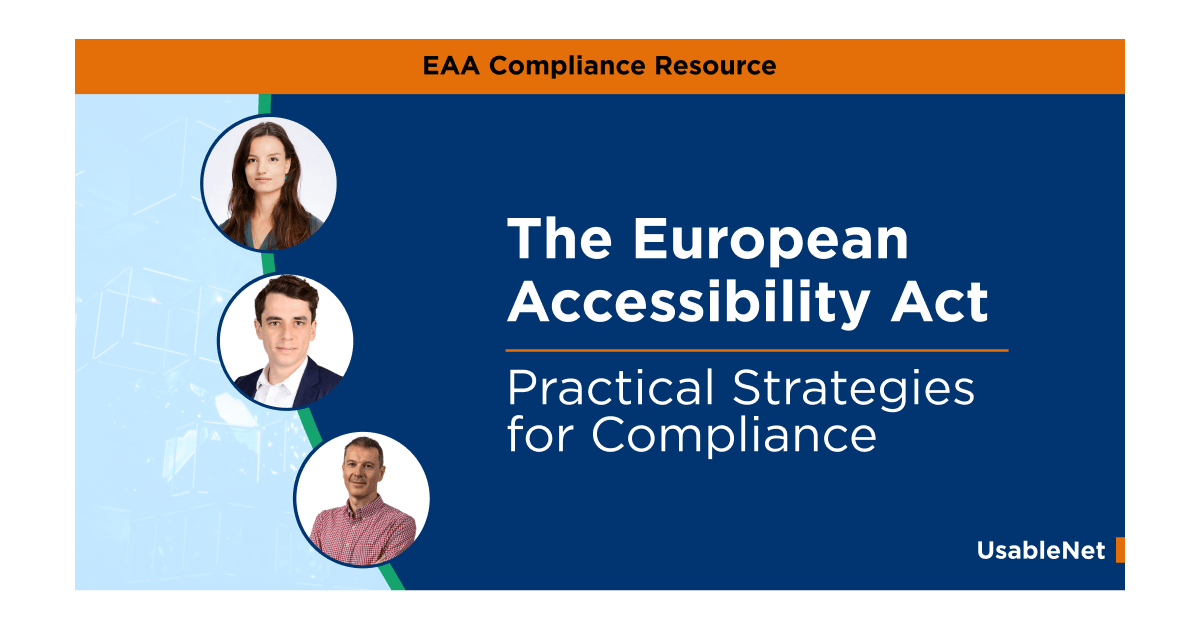Expand your business to European customers confidently by complying with the European Accessibility Act (EAA). Even if your company is based outside the EU, such as in the US or UK, you must meet EAA accessibility requirements if your products or services are offered to EU consumers.
For a complete guide on EAA compliance for non-EU companies, visit our European Accessibility Act guide.
Understanding these requirements is critical for ensuring smooth entry into European markets and compliance. Read on to learn about EEA compliance for non-EU companies, and what they need to know about aligning with EN 301 549 accessibility standards to successfully reach European customers.
Book a 15-minute consultation to review your EAA readiness.
Why Non-EU Companies Must Comply with the EAA
If your business operates outside the EU, you might assume that regulations like the European Accessibility Act (EAA) don’t apply to you. However, if your products or services are accessible to customers within the EU—whether through a website, mobile app, or digital platform—you’re still subject to the EAA accessibility requirements.
The EAA ensures that digital platforms and services across the EU are accessible to people with disabilities. EAA compliance for US companies and companies outside of the EU is critical to serving European customers.
Harmonizing accessibility standards under the EAA simplifies compliance across EU markets and makes it easier for businesses to operate internationally. In addition to legal requirements, complying with the EN 301 549 accessibility requirements also enhances your brand's reputation as inclusive and socially responsible.
Download our European Accessibility Act Compliance Guide
Understanding EN 301 549: The Key to EAA Compliance
The EN 301 549 standard, which outlines the accessibility requirements for digital products and services, is at the heart of EAA compliance for non-EU companies. Understanding and aligning with EN 301 549 is crucial for non-EU companies to ensure compliance with the EAA.
Here are some critical areas covered by EN 301 549:
- Web accessibility: Your website should be fully accessible to people using assistive technologies like screen readers and keyboard navigation.
- Software and apps: Ensure that your digital applications, whether mobile or desktop-based, meet the necessary accessibility criteria.
- Hardware: Products like smartphones, computers, ATMs, and payment terminals must also comply with accessibility requirements.
- Documentation: User guides, customer support materials, and other documentation must be accessible to people with disabilities, ensuring an inclusive user experience across all touchpoints.
While WCAG is often the starting point for web accessibility, EN 301 549 extends beyond WCAG standards, covering a more comprehensive range of products and services. Even if your digital products comply with WCAG, you’ll need to take additional steps to meet EN 301 549 accessibility requirements, especially if you provide multiple digital services or hardware.
Want to know more about the EN 301 549 standard? Check out our detailed post on Understanding EN 301 549 and its role in EAA compliance
How the European Accessibility Act Complements Previous Accessibility Efforts
The European Accessibility Act (EAA) builds on earlier accessibility directives like Directive 2016/2102, which set accessibility standards for public-sector websites and mobile apps. While Directive 2016/2102 laid the groundwork, the EAA expands accessibility requirements to include private-sector companies, e-commerce platforms, telecommunications services, and more.
The earlier directive primarily aimed at making public-sector digital products “perceivable, operable, understandable, and robust.” In contrast, the EAA broadens these standards, applying them to a wider range of digital products and private businesses.
Key milestones of the EAA include:
- June 2022: EU member states must adopt laws and administrative measures to meet EAA standards.
- June 28, 2025: The deadline when EAA provisions fully take effect, giving customers the right to file complaints against non-compliant businesses.
Meeting EN 301 549 accessibility requirements is important to ensure EAA compliance for non-EU companies. The EAA also seeks to reduce barriers to trade by harmonizing accessibility standards across the EU, making it easier for businesses to comply in multiple markets without navigating divergent national regulations.
For a look at key milestones and deadlines, head over to our blog on EAA compliance milestones.
The Business Benefits of EAA Compliance for Non-EU Companies
EAA compliance for US companies and other non-EU companies isn’t just about avoiding fines and legal issues; it’s also an opportunity to expand your market reach. By prioritizing accessibility, you can tap into the large, often overlooked market of users with disabilities. Accessibility improvements benefit everyone, including users with temporary impairments or older individuals.
Furthermore, aligning with EN 301 549 accessibility requirements improves your brand’s reputation by positioning your company as socially responsible and inclusive. As accessibility becomes a competitive advantage, businesses that embrace these standards will stand out in the marketplace.
For more in-depth strategies on managing EAA compliance for non-EU companies, explore our guide on cost-efficient EAA compliance strategies
Start Your EAA Accessibility Journey
Understanding and adhering to EN 301 549 is a critical first step. By conducting regular audits and integrating accessibility into your development processes, you can ensure that your products meet EAA requirements and are accessible to all users.








